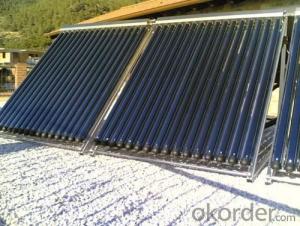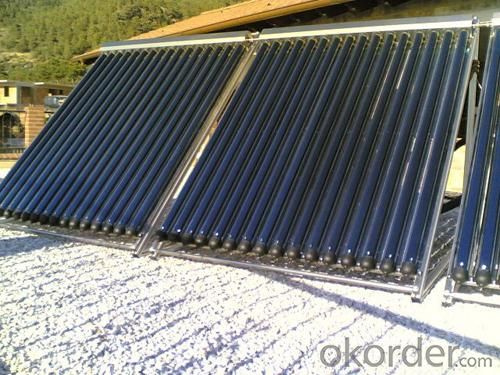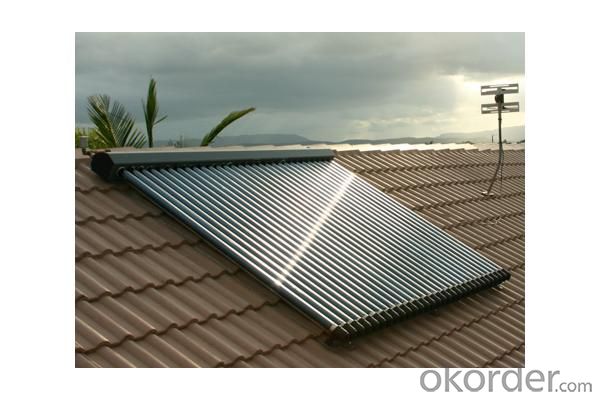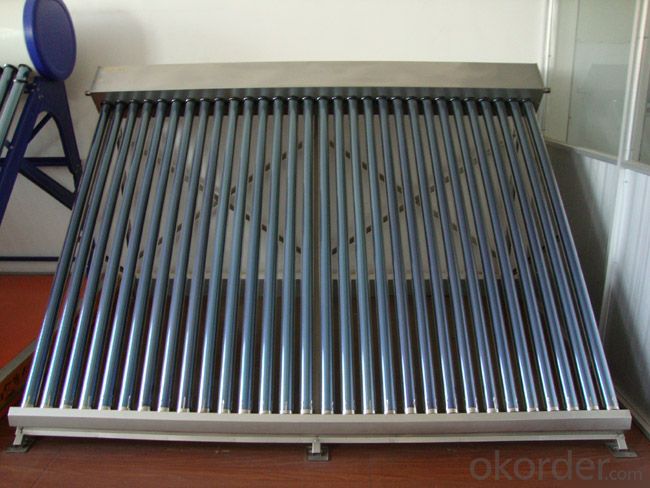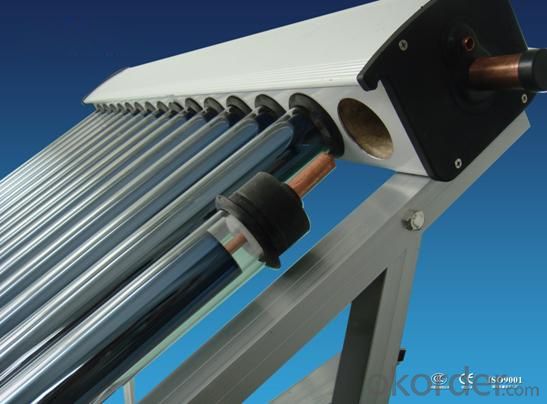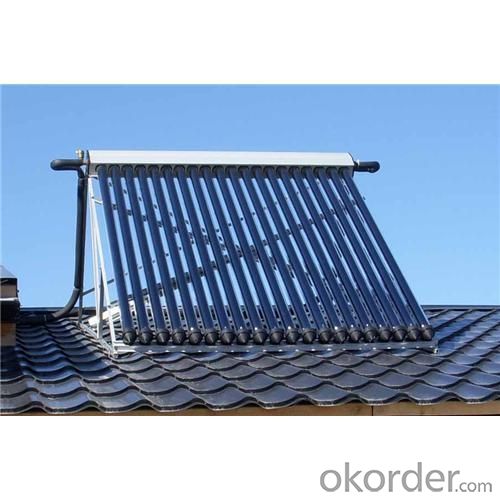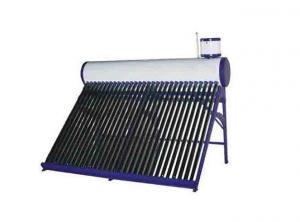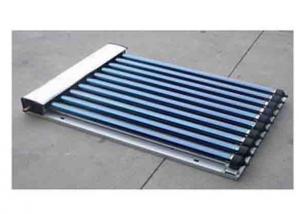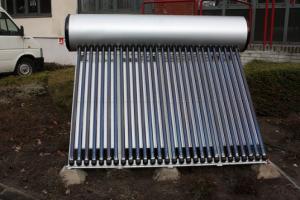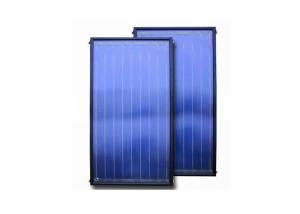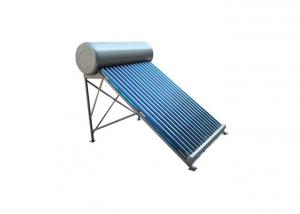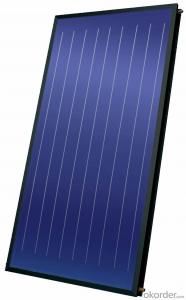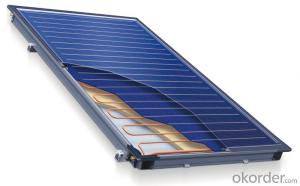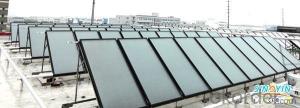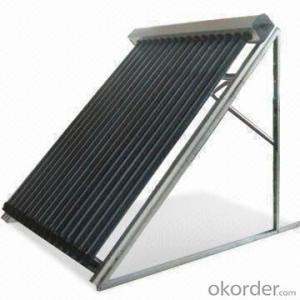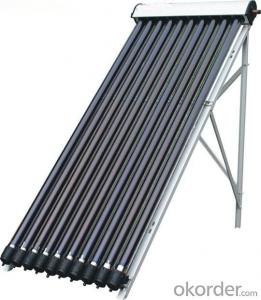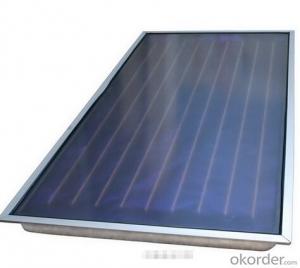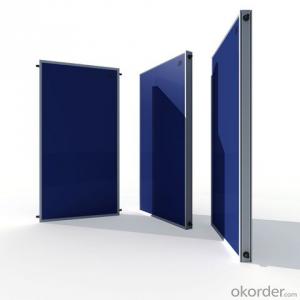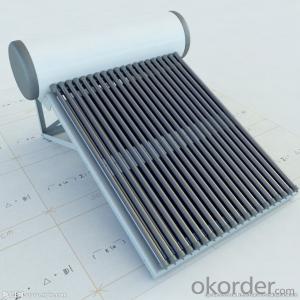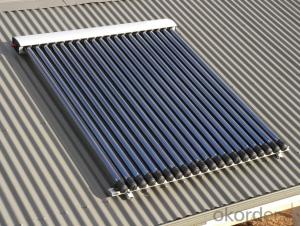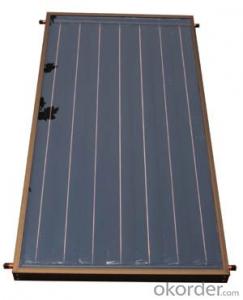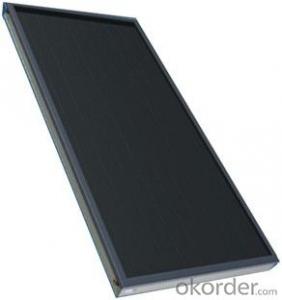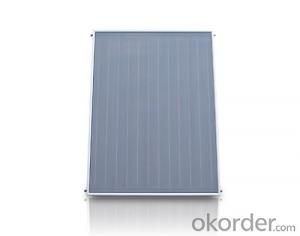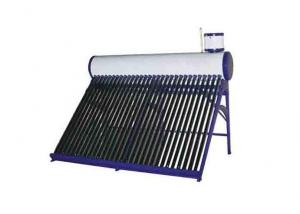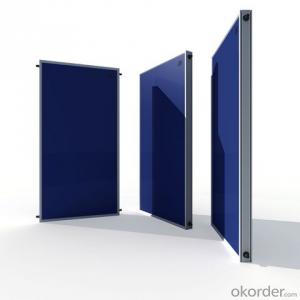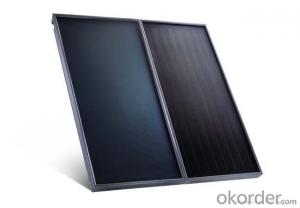Best Evacuated Tube Solar Collectors - High Efficiency Heat Pipe Vacuum Tubes
- Loading Port:
- China main port
- Payment Terms:
- TT OR LC
- Min Order Qty:
- 5 set
- Supply Capability:
- 10000 set/month
OKorder Service Pledge
OKorder Financial Service
You Might Also Like
Specification
manifold (inner) | red copper |
manifold (exterior) | aluminum alloy |
glass tube dimensions | 58mm * 1800mm |
daily efficiency | ≥55% |
heat preservation | 72 hours |
hail resistance | 25mm |
max pressure | 7 bar |
coating of vacuum tube | ALN/AIN-SS/CU |
heat pipe | anti-freezing > -35 degree |
certificate | Solar Keymark, EN12975,SRCC |
Serious Product
Models | L*W*H mm | Vacuum tube | Power output | Efficiency | Header mm | Frame | container loading 20FT/40HQ sets | Gross Weight kg |
SHC-8 | 1917*910*133 | 58*1800*8pcs | 939W | 0.668 | Φ35/1.0 | AL alloy | 185/445 | 27 |
SHC-10 | 1917*1130*133 | 58*1800*10pcs | 1189W | 159/385 | 33 | |||
SHC-12 | 1917*1350*133 | 58*1800*12pcs | 1440W | 149/358 | 40 | |||
SHC-15 | 1917*1680*133 | 58*1800*15pcs | 1815W | 120/290 | 49 | |||
SHC-18 | 1917*2010*133 | 58*1800*18pcs | 2191W | 100/242 | 59 | |||
SHC-20 | 1917*2230*133 | 58*1800*20pcs | 2442W | 87/210 | 66 | |||
SHC-22 | 1917*2450*133 | 58*1800*22pcs | 2692W | 83/202 | 72 | |||
SHC-24 | 1917*2670*133 | 58*1800*24pcs | 2943W | 77/188 | 79 |
Packaging & Delivery
Packaging Details: | Exporting Carton with big foaming protection |
Delivery Detail: | In 10-15 days |
Loading Quantity
Model | Tube | Tube Q.T.Y | Loading Q.T.Y/40HQ |
GSC15 | 58*1800mm | 15pcs | 315sets |
GSC18 | 58*1800mm | 18pcs | 265sets |
GSC20 | 58*1800mm | 20pcs | 248sets |
GSC22 | 58*1800mm | 22pcs | 225sets |
GSC25 | 58*1800mm | 25pcs | 200sets |
GSC30 | 58*1800mm | 30pcs | 168sets |
Details of solar collector:
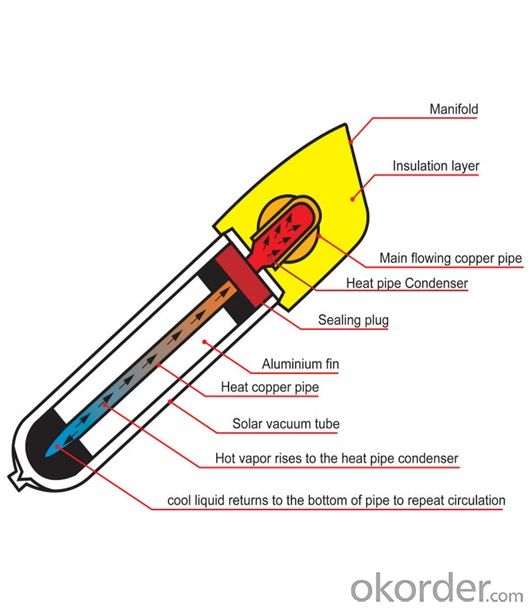
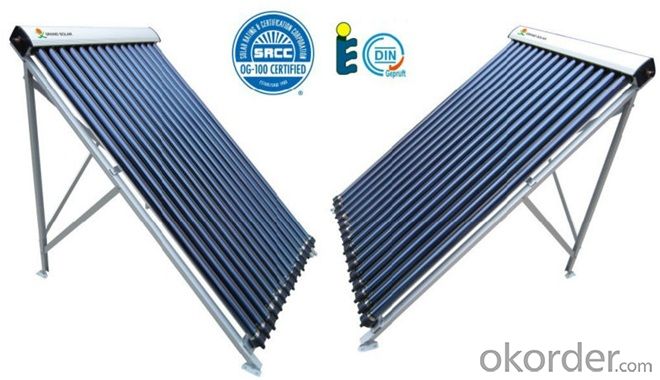
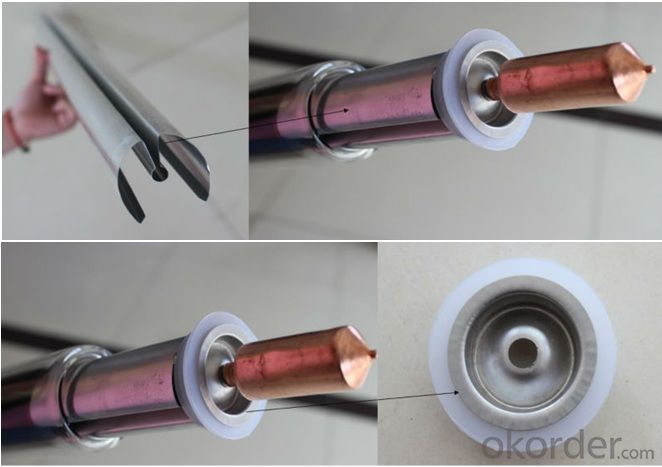
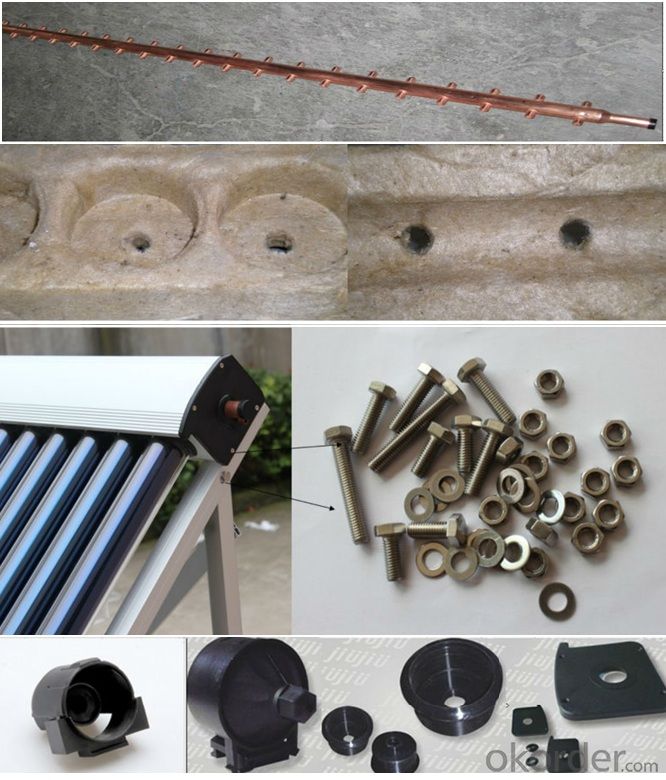
- Q: Can solar collectors be used for heating textile factories?
- Yes, solar collectors can be used for heating textile factories. Solar thermal systems can provide a sustainable and cost-effective solution for heating needs in industrial settings, including textile factories. By harnessing the sun's energy, solar collectors can generate heat and transfer it to the factory, reducing reliance on fossil fuels and lowering carbon emissions. Additionally, solar heating systems can be customized to meet specific requirements and integrated with existing heating systems, making them a viable option for textile factories aiming to reduce their environmental impact and energy costs.
- Q: Can solar collectors be used in military operations?
- Yes, solar collectors can be used in military operations. They can provide a reliable and renewable source of energy for various applications, such as powering communication systems, charging batteries, lighting, and heating water. Solar collectors are portable, easy to deploy, and can reduce dependence on traditional fuel sources, making them an efficient and sustainable option for military operations in remote or off-grid locations.
- Q: Can solar collectors be used for generating electricity on warehouses?
- Yes, solar collectors can be used for generating electricity on warehouses. Solar collectors, also known as solar panels, can be installed on the rooftop of warehouses to harness sunlight and convert it into electricity. These panels are made up of photovoltaic cells that absorb sunlight and generate direct current (DC) electricity. This DC electricity is then converted into alternating current (AC) electricity through an inverter, which can be used to power the electrical systems within the warehouse or even feed excess electricity back into the grid. Solar collectors are a sustainable and environmentally-friendly way of generating electricity, as they rely on renewable energy sources and produce zero greenhouse gas emissions. Additionally, installing solar collectors on warehouses can help businesses reduce their dependence on fossil fuels, lower their electricity bills, and contribute to a cleaner energy future.
- Q: Can solar collectors be used for heating barns?
- Yes, solar collectors can be used for heating barns. Solar collectors, such as solar thermal panels or air collectors, can harness the sun's energy to provide heat for barns. This renewable energy source can help reduce heating costs and provide a sustainable heating solution for barns.
- Q: Are solar collectors suitable for hospitals and healthcare facilities?
- Yes, solar collectors are suitable for hospitals and healthcare facilities. Solar collectors, also known as solar thermal systems, harness the energy from the sun to generate heat, which can be used for various purposes including water heating, space heating, and even powering cooling systems. Hospitals and healthcare facilities have significant energy requirements due to their round-the-clock operations, which include heating, cooling, and hot water needs. By incorporating solar collectors into their infrastructure, these facilities can significantly reduce their dependence on traditional energy sources, leading to cost savings and environmental benefits. Solar collectors are versatile and can be integrated into new constructions or retrofitted into existing buildings. They can be installed on rooftops, facades, or even as standalone structures. Furthermore, advancements in technology have made solar collectors more efficient and reliable, ensuring a consistent supply of renewable energy. The use of solar collectors in hospitals and healthcare facilities can also contribute to their sustainability goals and enhance their reputation as environmentally responsible institutions. By reducing carbon emissions, these facilities can mitigate their environmental impact and play a role in combating climate change. Additionally, solar collectors have the potential to provide a reliable energy source during power outages or emergencies. This is crucial for healthcare facilities, as uninterrupted power supply is essential for critical operations and patient care. In conclusion, solar collectors are indeed suitable for hospitals and healthcare facilities. They offer a sustainable and cost-effective solution to meet the high energy demands of these institutions while reducing their carbon footprint and promoting environmental stewardship.
- Q: Are there any limitations to the lifespan of solar collectors?
- Yes, there are limitations to the lifespan of solar collectors. Over time, solar collectors can experience wear and tear due to exposure to the elements, such as extreme temperatures, UV radiation, and weather conditions. This can lead to degradation of materials, decreased efficiency, and potential component failures. Additionally, the overall lifespan of a solar collector can also be influenced by the quality of its manufacturing, installation, and maintenance. However, with proper care and regular inspections, solar collectors can have a lifespan of 20 to 30 years or even longer.
- Q: Can solar collectors be used in remote areas without access to the grid?
- Yes, solar collectors can be used in remote areas without access to the grid. Since solar collectors generate electricity by harnessing energy from the sun, they can operate independently without needing to be connected to the grid. This makes them a viable solution for providing power to remote areas where grid infrastructure is absent or unreliable.
- Q: How do solar collectors impact job creation?
- Solar collectors have a positive impact on job creation as they require skilled professionals for manufacturing, installation, and maintenance. The growth of the solar industry has created numerous job opportunities in these sectors, resulting in increased employment and economic development.
- Q: Can solar collectors be used in solar thermal space heating?
- Yes, solar collectors can be used in solar thermal space heating. Solar thermal space heating systems utilize solar collectors to absorb the sun's energy and convert it into heat. These collectors, often made of materials like glass or metal, capture the sun's rays and transfer the heat to a fluid, such as water or antifreeze. This heated fluid is then circulated through a system of pipes or tubes, transferring the heat to the space that needs to be heated. Solar collectors for space heating can come in different forms, including flat-plate collectors, evacuated tube collectors, or even air collectors. The choice of collector type depends on factors such as efficiency, cost, and specific heating requirements. Solar thermal space heating systems provide a sustainable and renewable alternative to conventional heating methods, as they use the sun's energy, which is abundant and free. They can be particularly effective in regions with ample sunlight, and when properly designed and installed, they can significantly reduce or even eliminate the need for traditional heating fuels like gas or oil. Additionally, solar thermal space heating systems can have a positive impact on reducing greenhouse gas emissions and dependence on fossil fuels. However, it is important to note that solar thermal space heating systems may not be suitable for all situations. Factors such as climate, building orientation, available space, and heating demand should be considered before deciding to install such a system. Additionally, proper maintenance and system design are crucial to ensure optimal performance and longevity. In conclusion, solar collectors can indeed be used in solar thermal space heating systems, providing a sustainable and cost-effective way to heat spaces using the sun's energy.
- Q: Can solar collectors be used for heating shopping centers?
- Yes, solar collectors can be used for heating shopping centers. Solar thermal systems can be installed to capture and convert sunlight into heat energy, which can then be used for space heating purposes in shopping centers. This can help reduce the reliance on traditional heating systems, lower energy costs, and contribute to a more sustainable and environmentally friendly approach to heating large commercial spaces.
Send your message to us
Best Evacuated Tube Solar Collectors - High Efficiency Heat Pipe Vacuum Tubes
- Loading Port:
- China main port
- Payment Terms:
- TT OR LC
- Min Order Qty:
- 5 set
- Supply Capability:
- 10000 set/month
OKorder Service Pledge
OKorder Financial Service
Similar products
Hot products
Hot Searches
